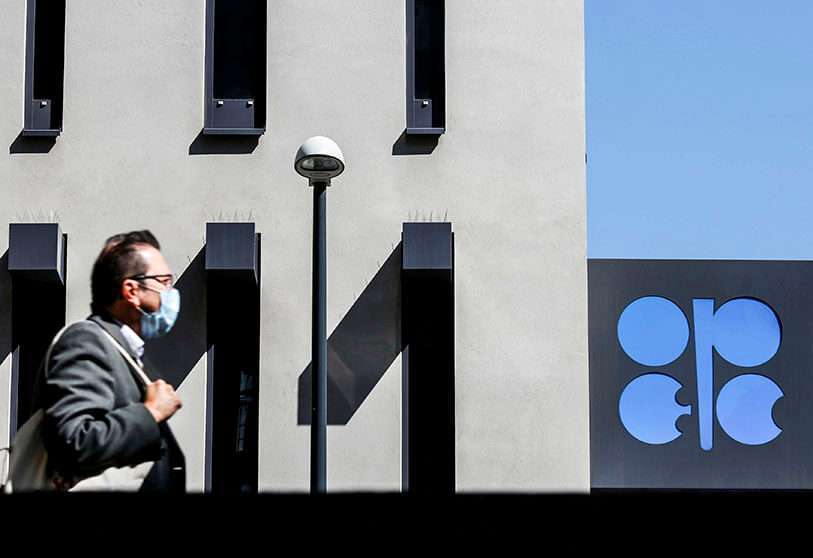OPEC agrees to cut oil production to stabilize barril prices

The negotiations have lasted until the last minute, but this time there is white smoke. The oil powers agreed on Sunday night to make a record cut in oil production to stabilise oil prices. They will stop pumping up to 9.7 million barrels a day in May and June, drop to eight million a day between July and December, and six million between January 2021 and April 2022. The health crisis caused by the coronavirus, which has collapsed the demand for hydrocarbons, and Saudi Arabia's strategy of multiplying the supply in the face of the disagreement with Russia have led to the Brent barrel and the Texas barrel registering prices from two decades ago and causing great volatility in the market.
Around thirty countries grouped in the OPEC+ alliance, headed by Riyadh, and Moscow as the leader of the external allies, have closed the agreement after marathon days of teleconferencing since last Thursday. "These production adjustments are historic," assessed OPEC Secretary General Mohamed Barkindo. "We are witnessing today the triumph of international cooperation and multilateralism, which are at the core of OPEC's values," he said on his Twitter account.

Despite the enormous flow of oil that is being considered to stop pumping, it remains to be seen if this will be enough to stabilize the previous ones in the face of the collapse in demand caused by the COVID-19 pandemic. "We have shown that OPEC is awake and alive," Saudi energy minister Abdulaziz bin Salman told Bloomberg TV just minutes after the deal was announced.
The low prices of crude oil are good news for Spain or China, which don't have these raw materials and have to import them, although it’s a burden for the development of new renewable energies. The cost of producing them is higher than buying cheap oil.
The difficulty of the negotiation and the urgency of reaching an agreement - just a few hours before the opening of the markets in Asia - have been reflected in a long series of video conferences in different formats over the last four days, either within the OPEC + alliance, or the G20, which this year is chaired by Saudi Arabia. Barkindo emphasises that this agreement opens the way to a global alliance with the participation of the G20 that marks a milestone in the history of oil cooperation.
Also, unprecedented, the leaders of the world's three largest crude oil producers - and competitors in a normal situation for a share of the market - the United States, Saudi Arabia and Russia, have backed the agreement. Presidents Donald Trump and Vladimir Putin and King Salman bin Abdulaziz supported the agreement in a telephone conversation on Sunday. "The leaders supported the agreement reached within OPEC+ on the voluntary and gradual limitation of oil production to stabilize world markets and ensure the sustainability of the global economy as a whole," the Kremlin said in a statement.

"The big oil deal with OPEC+ is done. It will save hundreds of thousands of energy jobs in the United States," US President Donald Trump wrote on Twitter. "It's a great deal for all of us," he stressed in his profile. It appears that pressure from Washington has been key to unraveling an agreement with numerous countries and competing interests, including unexpected resistance from Mexico.
The agreement means ratifying, in broad terms, what was outlined by OPEC + last Thursday, with a staggered plan: the reduction of almost 10 million barrels a day during May and June, would drop to eight million barrels a day between July and December, and six million barrels between January 2021 and April 2022.
The final agreement has been reached when the stumbling block of Mexico, which refused to cut the 400,000 barrels per day it was originally demanded, was saved and now only 100,000 barrels per day have to be withdrawn. The United States will take over the 300,000 barrels per day that its southern neighbour is failing to cut in the final version of the pact.
The pandemic was accompanied by a price war initiated in March between Russia and Saudi Arabia, after the failure of the agreement to maintain the cuts advocated within the framework of OPEC+, which plunged oil prices to their lowest levels in two decades.
Iran's oil minister, Bijan Namdar Zanganeh, said after the meeting that leading OPEC members, as well as its main producer, Saudi Arabia, and others such as the United Arab Emirates and Kuwait, have also agreed to a joint additional cut of two million barrels a day.
Zanganeh has also explained, according to Iranian media, that countries outside the OPEC+ alliance were willing to cut their production by 3.7 million barrels a day, including the 300,000 barrels assumed by the US on behalf of Mexico. The G20 energy ministers concluded their meeting last Friday without a concrete promise on a production reduction, so it is not clear what cut the participating countries will assume.
The International Energy Agency (IEA) recently estimated that global demand for oil may fall by as much as 20 million barrels a day this quarter due to measures to curb the spread of VOC-19, with some 3.5 billion people confined to their homes.
While the cuts by OPEC+ and other producers may lead to a rebound in oil prices, some analysts doubt that they will be able to stabilize the market because the measures will start to be implemented in May. This leaves almost three weeks of production well above demand, which may dampen the effect of the spigot closure in the following months.








